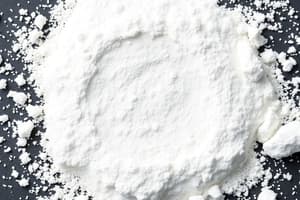Podcast
Questions and Answers
What is the main difference between matter and energy?
What is the main difference between matter and energy?
- Matter is made up of atoms, while energy is made up of subatomic particles
- Matter exists in solid, liquid, and gas states, while energy exists in potential and kinetic forms
- Matter occupies space and has mass, while energy does not occupy space and has no mass (correct)
- Matter has chemical composition, while energy does not have a chemical composition
Which of the following is a homogeneous mixture according to the classification of matter?
Which of the following is a homogeneous mixture according to the classification of matter?
- Lime + Water
- Salt solution (correct)
- Sugar solution
- Rise + Sand
What are the main subatomic particles that make up an atom?
What are the main subatomic particles that make up an atom?
- Alpha particles, beta particles, and gamma rays
- Protons, electrons, and neutrons (correct)
- Quarks, leptons, and bosons
- Photons, neutrinos, and muons
According to the nuclear model put forward by Ernest Rutherford, where is the nucleus located within an atom?
According to the nuclear model put forward by Ernest Rutherford, where is the nucleus located within an atom?
What is the charge of a neutron?
What is the charge of a neutron?
Which statement best describes the electron within an atom?
Which statement best describes the electron within an atom?
Flashcards are hidden until you start studying
Study Notes
- Matter and energy are the two main categories of things in our environment.
- Matter is that which occupies space and has mass.
- Classification of matter: Pure substances (Elements, Compounds), Physical nature (Solid, Liquid, Gas), Chemical composition (Homogeneous mixtures, Heterogeneous mixtures).
- Atoms are the basic units of matter.
- Atoms consist of subatomic particles: Protons, Electrons, and Neutrons.
- Protons have a positive charge, electrons have a negative charge, and neutrons have no charge.
- Nuclear model introduced to explain organization of particles in matter.
- Nucleus, a small area at the center of an atom, contains most of an atom's mass.
- Size of a nucleus is even smaller than a chickpea.
Studying That Suits You
Use AI to generate personalized quizzes and flashcards to suit your learning preferences.




